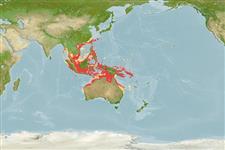>
Eupercaria/misc (Various families in series Eupercaria) >
Nemipteridae (Threadfin breams, Whiptail breams)
Etymology: Nemipterus: Greek, nema, -atos = filament + Greek, pteron = wing, fin (Ref. 45335).
More on authors: Quoy & Gaimard.
Environment: milieu / Klimaatzone / Diepte / distribution range
Ecologie
marien demersaal; standvastig; diepte 10 - 80 m (Ref. 9785). Tropical; 27°N - 28°S, 93°E - 165°E (Ref. 3810)
Western Pacific: Andaman Sea to the Solomon Islands.
Grootte / Gewicht / Leeftijd
Maturiteit: Lm ? range ? - ? cm
Max length : 23.0 cm SL mannelijk / geslacht onbekend; (Ref. 108462); common length : 15.0 cm SL mannelijk / geslacht onbekend; (Ref. 9785)
Dorsale stekels (totaal) : 10; Dorsale zachte stralen (totaal) : 9; Anale stekels: 3; Anale zachte stralen: 7. Suborbital spine absent. Preopercle with 3 transverse scale rows. Pectoral fins long, reaching to or beyond level of anus. Pelvic fins very long, reaching to or just beyond level of anus. A line drawn up from posterior edge of suborbital reaching the dorsal profile at about 2 to 6 scale rows before origin of dorsal fin. Upper lobe of caudal fin slightly longer than lower, tipped with yellow. Females predominate at small sizes, males at larger sizes. Axillary scale present. Color: Upper body pinkish, silvery white below.
Body shape (shape guide): fusiform / normal; Cross section: oval.
Occurs on mud or sand bottoms. Most abundant in depths of 20 to 50 m. Feeds mainly on small shrimps, squid, small fishes and benthic animals.
Levenscyclus en paargedrag
Maturiteit | Voortplanting | Paaien | Eieren | Fecunditeit | Larven
Females predominate at small sizes and males at larger sizes as result of faster growth rates in males.
Russell, B.C., 1990. FAO Species Catalogue. Vol. 12. Nemipterid fishes of the world. (Threadfin breams, whiptail breams, monocle breams, dwarf monocle breams, and coral breams). Family Nemipteridae. An annotated and illustrated catalogue of nemipterid species known to date. FAO Fish. Synop. 125(12):149p. Rome: FAO. (Ref. 3810)
Status op de Rode Lijst van het IUCN (Ref. 130435: Version 2025-1)
Gevaar voor de mens
Harmless
Gebruik door de mens
Visserij: van minder commercieel belang
Tools
Speciale rapporten
Download XML
Internetbronnen
Estimates based on models
Preferred temperature (Ref.
123201): 25 - 29, mean 28.1 °C (based on 1040 cells).
Fylogenetische diversiteitsindex (Ref.
82804): PD
50 = 0.5000 [Uniqueness, from 0.5 = low to 2.0 = high].
Bayesian length-weight: a=0.01445 (0.01206 - 0.01733), b=2.97 (2.94 - 3.00), in cm total length, based on LWR estimates for this species (Ref.
93245).
Trofisch niveau (Ref.
69278): 3.9 ±0.3 se; based on diet studies.
Generation time: 1.4 (1.1 - 2.3) years. Estimated as median ln(3)/K based on 12
growth studies.
Weerstandsvermogen (Ref.
120179): Hoog, minimale populatieverdubbelingstijd minder dan 15 maanden (K=0.4-0.6).
Fishing Vulnerability (Ref.
59153): Low vulnerability (19 of 100).
🛈
Nutrients (Ref.
124155): Calcium = 525 [123, 997] mg/100g; Iron = 1.51 [0.47, 4.18] mg/100g; Protein = 17.8 [16.1, 19.4] %; Omega3 = 0.28 [0.13, 0.62] g/100g; Selenium = 36 [14, 111] μg/100g; VitaminA = 17.3 [4.1, 98.1] μg/100g; Zinc = 0.781 [0.446, 2.664] mg/100g (wet weight);
